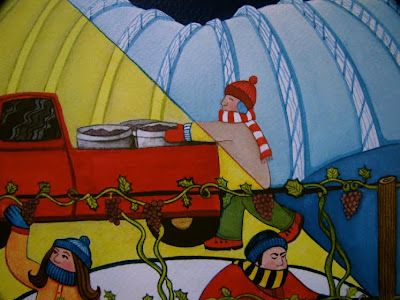
"The Ice Wine Harvest", Gouache on Watercolour paper, 11x14
I grew up in the Okanagan Valley, a region famous for fruit. When the cherries were ripe, I knew it was time for summer holidays. When the peaches were off the trees and the apples were on their way, it was time to go back to school. But now, with orchards being ripped out in favour of more lucrative vineyards, grapes are taking over my little valley. And with that comes ice wine.
I first heard about ice wine when I was living in Taipei. I had no idea what it was, but the Taiwanese loved it and coveted bottles of it imported from Canada. One day, as I was walking down the busiest shopping street of Chungsiao East Road, I happened to casually look into a store, and stop dead in my tracks:
Up along the back wall of the store, was a string of Canadians flags celebrating Canadian ice wine. But between each flag was another flag of a first Nations pictograph. I recognised this pictograph. I had drawn it several times as a young girl guide on a hike up through Paradise Ranch above Naramata. Yes, Paradise Ranch Ice Wine from Naramata was being not only sold, but celebrated in Taipei! That's when I realised how far reaching Naramata's wine industry had become.

Any idea how ice wine is made? This is what I have come to understand from the people chatting about it over coffee here in Naramata. Certain primo ice wine grapes are left on the vine well after the normal harvest. Some places even put nets over the grapes to keep them safe on the wine as they shrivel and the vine weakens under the cooler fall days. Everyone waits until the temperature hits minus eight degrees celcius and Wham! Once that happens, the grapes have to come off the vines as quickly as possible before the weather warms up again.

Usually, the first time it hits minus eight degrees is at night. On-call Pickers motor up to the vineyards and get to work, under bright flood lights set up so the pickers can see. Working quickly, the grapes are collected and crushed into wine before they thaw. As the water in the grape is still frozen, the nectar crushed out of the grape is sweet and thick- liquid gold. It takes a significant number of grapes to produce icewine, and since the process must be completed before in warms up (The grapes are useless if they thaw) it's costly, hence why ice wine is expensive.

In this painting, "The Ice Wine Harvest," I wanted to convey the feeling of the ice wine harvesters working quickly and in unison under a beautiful but cold Canadian winter sky. You should feel a little cold just looking at it!
And a little off topic but an interesting fact nonetheless: Canadian wine tends to have an extremely high sugar content and therefore alcohol content because of their prolonged exposure to the sun during our long summer days. In fact, it often has to have the alcohol content percentage brought down because it has too much alcohol naturally! Neat, eh?
Click here to see fantastic little video from Inniskillin Ontario that explains the process of making icewine.
I hope you like it~!
xxMelanie
KAWPPU6TT7X9

Very nice. I see you've made a few changes to this one since the last time I saw it, all changes get the stamp of approval!
ReplyDeleteNext one has to be how critical tying vines are to the wine making process. DAYYYOOOOH
ReplyDeleteThanks, "anonymous.'" I had blocked that from my long term memory! All I have to say to you is "12 ply toilet paper!"
ReplyDeletegee Melanie!!! this was really interesting... excuse my ignorance hihi but I had never heard of the icewine before and now I would love to taste a glass of it!!! thanks for sharing it!
ReplyDelete